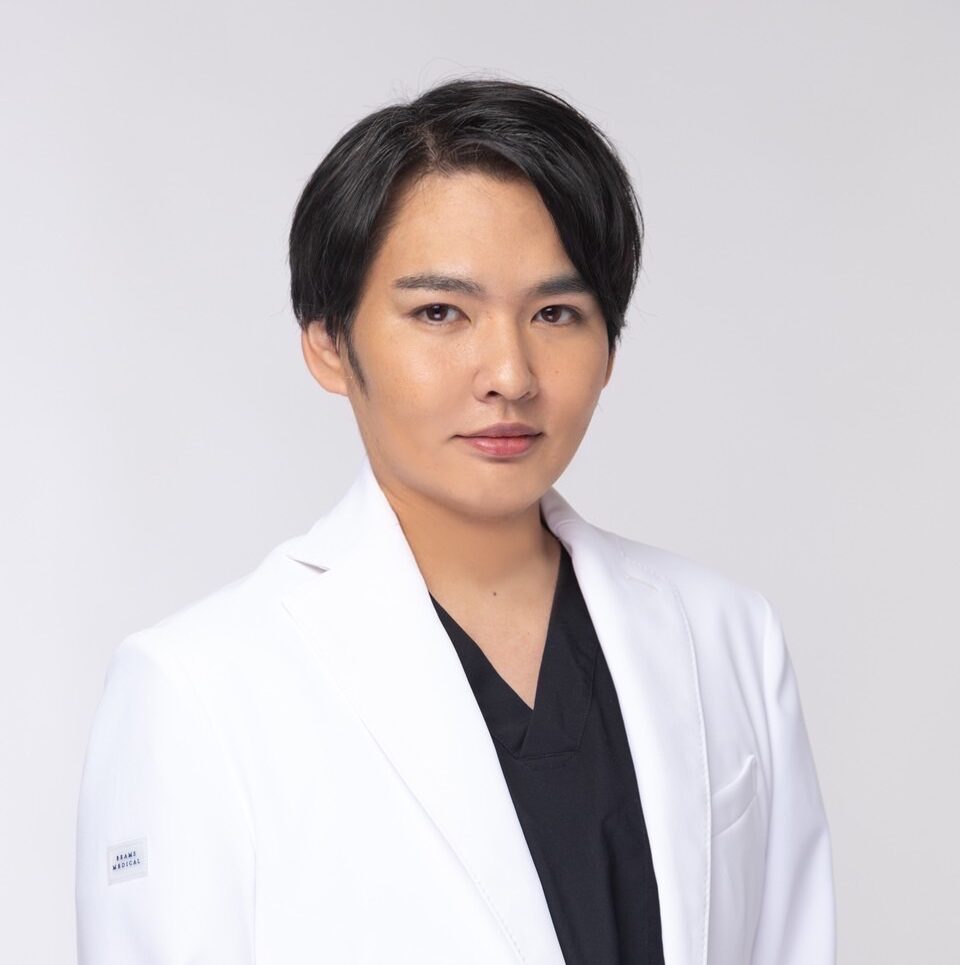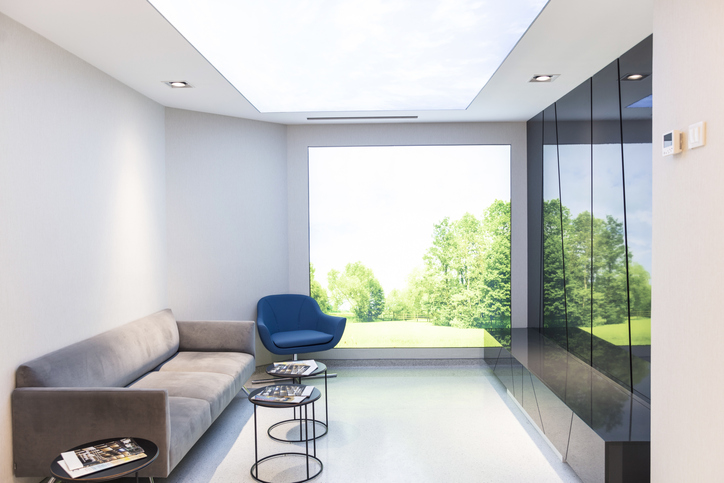Have you been to a dermatologist and diligently applied the prescribed medication, but for some reason the itchiness and rough skin persist? Are you at a loss as to the cause of your skin problems? The problem may not be caused by allergens such as certain foods or pollen, but by stress allergy, which is triggered by your stress.
Here, we will thoroughly elucidate the mechanism of the close relationship between the mind and skin from the viewpoint of specialists who have seen numerous cases. We will explain why it is so difficult to improve skin with standard dermatological treatments alone, and we will provide specific self-care to nurture healthy skin from the root and prevent problems from recurring, as well as specialized approaches that only cosmetic dermatology can provide. We have gathered here the knowledge you need to identify the unexplained skin problems that have plagued you for many years and take a solid step toward root cause improvement.

Graduated from the Faculty of Medicine, National Kumamoto University. After serving as the director of major beauty clinics in Japan, etc., he opened Aladdin Aesthetic Clinic in 2023. He is a professional in aesthetic medicine with a doctorate in anti-aging research and many years of experience. With the motto of "Toward the realization of cosmetic medicine without lies," he aims to be the "Only One" together with his patients.
- Could that itch be triggered by stress? How unexplained dermatitis occurs
- Why is improvement difficult with standard dermatological treatment alone?
- What is the lifestyle improvement program to "nurture skin"?
- The next step for skin problems that don't improve with self-care? The Clinic Approach
- summary
Could that itch be triggered by stress? How unexplained dermatitis occurs
As mentioned at the beginning, there is often an unseen cause called "stress" behind skin problems that do not clear up with dermatological treatment. Why do psychological problems affect the condition of the skin so much?
Here, we will explain in detail what is happening in your body based on the concept of "psychoneuroimmunology," which unravels this mysterious relationship. We have also prepared a self-check to find out why allergy tests show no abnormalities and to see if your own symptoms are related to stress.
Once the cause is understood, countermeasures can be found. Let's start by correctly understanding the true nature of the SOS signs your skin is giving off.
What is psychoneuroimmunology, the connection between mind and skin?
There is a saying that "sickness begins with the mind," but this is not mere mentalism. The scientific relationship between the mind (spirit), nerves, and immune system has been scientifically proven by the field of "PsychoNeuroImmunology," which studies how they exchange information with and influence each other.
When our body receives the stimulus of stress, the brain's control tower (hypothalamus) issues commands to the entire body. At this time, three systems play particularly important roles: the autonomic nervous system, hormones, and the immune system.
Autonomic Nervous System|"Accelerator" and "Brake" that cause disturbance
The autonomic nervous system consists of the sympathetic nervous system (accelerator), which is dominant during activity, and the parasympathetic nervous system (brake), which is dominant during relaxation.
When stress continues, the gas pedal is always on. This causes blood vessels to constrict and blood flow, which delivers nutrients and oxygen to every corner of the skin, deteriorates. This is a direct cause of skin cell turnover, which results in a deterioration of the skin's barrier function.
Hormones|"Stress Hormones" Runaway
When stressed, the adrenal glands secrete a stress hormone called cortisol. Cortisol essentially has an important role in reducing inflammation, but when secretion continues due to excessive stress, it can have a negative effect on the skin by suppressing immune function and causing excessive sebum production.
Immunity|"Body Guard" in disarray
Immunity is the "guard" that protects the body from external invaders (such as viruses). However, when the autonomic nervous system and hormones are out of balance, this guard becomes confused. The body overreacts to even minor stimuli (sweat, friction of clothing, etc.) to which it normally does not have to react, releasing a substance called histamine, which causes allergic reactions such as itching and redness. This causes allergy-like symptoms such as itching, redness, and hives.
These three systems are not independent, but influence each other. This negative spiral, starting with stress, is the true cause of dermatitis of unknown origin.
Why do symptoms occur even when allergy tests are "normal"?
The experience of "having allergy symptoms but no reaction in the blood test" is a problem that plagues many patients. The reason for this is that the mechanism of occurrence is fundamentally different between "immediate-type allergies," which are examined by general allergy tests, and stress-related skin symptoms.
A typical allergy test measures the amount of a protein called "IgE antibody" that the body produces in response to specific causative agents (allergens) such as dust mites, cedar pollen, and food. Allergic reactions are triggered when IgE antibodies bind to allergens.
On the other hand, in most cases, skin symptoms caused by stress do not involve these IgE antibodies. As mentioned above, the entire immune system is hypersensitive due to autonomic nervous system and hormonal disturbances, causing a "malfunction" so to speak. Since there is no specific enemy (allergen), it is not detected as an abnormality in allergy tests that examine IgE antibodies. The differences between the two are summarized in the table below.
| immediate allergy | Stress-related skin symptoms | |
|---|---|---|
| cause | Specific allergens (pollen, food, mites, etc.) | Mental and physical stress, lifestyle disturbances |
| Reactions in the body | IgE antibodies are produced and react to allergens | Autonomic, hormonal, and immune imbalances and immune malfunction |
| Reaction on Inspection | Prone to positive reactions in allergy tests (e.g., blood tests) | Allergy tests often show "no abnormality (negative) |
| Symptoms | Symptoms appear within a relatively short time after contact with the causative agent | Chronic, recurring, on and off, due to accumulated stress |
Thus, the first step toward a fundamental solution is to look at the background of symptoms, rather than to be happy or sad about the test results.
Why is improvement difficult with standard dermatological treatment alone?
In the previous chapter, we explained the possibility that unexplained skin problems may result from stress-induced physical and mental imbalances. The next question many of you may ask is, "Then why can't I get rid of it fundamentally, even with dermatologist-prescribed medications?" The next question many people may have is, "Then, why can't I get a fundamental cure with the drugs prescribed by dermatologists?
Here, we will carefully unpack the reasons for this. The goal is not to deny the standard treatment provided by dermatology, but to properly understand its important role and the "limitations" that cannot be overcome by it alone.
By clearing up misconceptions about topical steroids and shedding light on the challenges facing modern medicine and the root causes we tend to overlook, your approach to treatment will change and a new path will emerge.
Important role and limitations of symptomatic treatment (e.g., topical steroids)
First of all, you must understand the basic premise that topical steroids and antihistamines (anti-itch medications) prescribed by dermatologists are very important and essential treatments to control the painful symptoms that are occurring right now.
If skin inflammation is likened to a "fire," these medications serve as "fire engine water" that quickly extinguishes the fire. If a fire of severe itching and redness is left unchecked, there is a risk of scratching, further damaging the skin barrier function and causing bacterial infection (spreading the fire). Symptomatic treatment to quell the fire first is an extremely effective first step in treatment.
Some people may have the image that "steroids are scary," but there is no need to be overly concerned. There are five ranks of topical steroids according to the strength of their effects, and specialists accurately prescribe the most appropriate strength of medication, taking into consideration the severity of symptoms and body parts (e.g., thinness of skin). If used correctly under the guidance of a physician and in accordance with the dosage and administration, these drugs are safe and can be expected to have a high therapeutic effect while minimizing the risk of side effects.
On the other hand, however, there are limitations. These medicines are only for putting out "fires" and cannot extinguish the "spark" that is the root cause of the fire. As long as the spark of the fire remains in your body, such as stress or lifestyle disorder, the smoke will go up again and the inflammation (fire) will reoccur in the same way if you stop using the medicines. The experience of "it's fine while you are applying the medicine, but when you stop, it comes back" is a sign that this "spark" is still smoldering in your body.
Difficulty in identifying and treating "stress" as the cause
So why don't physicians provide more in-depth treatment for stress, the "spark" of the fire? This has to do with the structural difficulties faced by modern medicine, especially insurance care.
One of the great strengths of modern medicine is that it identifies the causes of disease and provides scientifically based treatment based on objective data such as blood tests and diagnostic imaging. However, the cause of "stress" cannot be easily quantified like blood pressure or blood sugar levels. How much stress one feels and what causes stress is an extremely personal matter and varies greatly depending on one's personality and the environment in which one is placed, making objective diagnosis very difficult.
Therefore, it is not easy for a physician to determine "the root cause of your skin problems is stress" in a consultation. In addition, there is a physical limit to the amount of time that can be spent on counseling and delving deeply into each patient's life background and problems at work and at home in the limited time available for consultation under the insurance system.
As a result, in many dermatological practices, treatment must focus on "symptomatic therapy" that suppresses the inflammation that is occurring in front of the patient. This is not due to negligence on the part of physicians, but rather to the difficulty of approaching causes that cannot be quantified, an issue common to all modern medical care.
Lifestyle disorders often overlooked as the root cause
In order to maximize the effects of medication and restore healthy skin that is less likely to recur, it is essential to review the "foundation" of treatment. That foundation is our "lifestyle.
Even with a great blueprint (treatment plan) and excellent building materials (medicine), a sturdy house cannot be built if the ground (body) on which the house is built is muddy. Lack of sleep, unbalanced diet, lack of exercise, excessive drinking and smoking. Each of these is an undeniable "spark" that disturbs the balance of our autonomic nervous system, hormones, and immune system, and puts our body under stress from the inside out.
In many cases, those who feel that their condition does not get better even after applying medication are unknowingly allowing such lifestyle disorders to become the norm, thereby preventing the medication from being effective. Even though it is difficult to approach the invisible cause of stress, we can change our daily lifestyle by ourselves if we are conscious of it. Establishing this foundation is the surest step to maximize the effects of medication and to quell the "spark" of inflammation.
So, what specific habits should be kept in mind to build a "strong foundation" to nurture the skin from the root? In the next section, we will introduce in detail the specific "lifestyle improvement program" recommended by doctors.
What is the lifestyle improvement program to "nurture skin"?
We hope you now understand why dermatological treatment alone is not enough to improve the condition, and that the "foundation" problem of lifestyle habits lies behind the difficulty. So, what kind of habits can we follow in order to quell the "spark" of inflammation and to nurture healthy skin that will not repeat the problem?
Here we present a specific program based on the scientific evidence recommended by doctors, divided into three pillars: defensive skin care, aggressive inner care, and mental care. These are important steps not only to maximize the effects of the medicine, but also to enhance your own healing power. Let's start with what you can do, one by one.
Skin Care for Protection: How to Strengthen the Barrier Function Based on Dermatological Science
When the skin is sensitive due to stress, it is most important to first review basic skin care to maintain the skin's natural "barrier function" normally, rather than adding expensive beauty products. From the perspective of dermatology, here are three major principles of "protective skincare" to protect the skin from external stimuli.
Gentle washing|Over-washing destroys the barrier function.
When itching or stickiness bothers us, we tend to scrub hard, but this is counterproductive. This is counterproductive. It also washes away the sebum film and natural moisturizing factor (NMF), which protect the skin's moisture, and causes the skin's barrier function to deteriorate.
When washing your face, use lukewarm water (32-34°C), thoroughly lather your face wash, and gently roll the lather over your skin. It is also important to rinse carefully all the way to the face line and hairline, as leaving residue on the skin can cause irritation.
Moisturize thoroughly|Cover with "moisture and oil
After washing the face, the skin is in a very vulnerable state as moisture easily evaporates. After replenishing moisture generously with lotion, be sure to cover with an oil-containing item such as milky lotion or cream to lock in moisture so that it does not escape. This "supplementation of both moisture and oil" is the ironclad rule for maintaining moisture.
Daily UV Protection|Protecting Skin from the Strongest Stimuli
UV rays are the largest external factor that causes skin dryness and directly destroys the barrier function. UV rays fall even on cloudy days and indoors, so make it a habit to use sunscreen daily, all year round, regardless of the season or weather.
When choosing skincare products, we recommend products containing ingredients such as "ceramide," "hyaluronic acid," and "niacinamide," which support the skin's barrier function. On the other hand, during sensitive skin, "alcohol (ethanol)," "fragrance," and "colorant" can be irritants, so it is best to choose hypoallergenic products that do not contain these ingredients.
Aggressive Inner Care: Dietary Techniques for Regulating Skin from the Intestinal Environment
Beautiful skin is created from within the body. In particular, as the term "gut-brain-skin correlation" has been attracting attention in recent years, it is known that the intestinal environment and skin condition are closely related.
When the intestinal environment deteriorates and bad bacteria increase, harmful substances generated in the intestines travel throughout the body in the bloodstream, reaching the skin and causing inflammation. In other words, adjusting the intestinal environment is truly "aggressive inner care" to extinguish the "spark" of skin inflammation.
Please refer to the following table to determine what to actively consume and what to avoid in your daily diet.
| Nutrients and foods to be actively consumed | Foods to avoid overconsumption | |
|---|---|---|
| Objective. | Increases beneficial bacteria in the intestines and inhibits inflammation | Disrupts the intestinal environment and promotes inflammation |
| concrete example |
|
|
Of course, you do not have to do everything perfectly. Let's start with something that you can easily continue to do, such as switching sweet drinks to water or tea, or mixing a little brown rice with your usual white rice.
Stress Coping with Scientific Basis
It is difficult to completely eliminate stress from our social lives. What is important is to learn how to manage stress without letting it accumulate (stress coping). Here are two scientifically proven self-care techniques.
Sleep hygiene guidance" for quality sleep
Sleep is the most important time to reset the disturbed autonomic nervous system and hormonal balance. Do not just sleep longer, but focus on "quality.
- Sunrise: When you wake up, the first thing you do is open the curtains to let the sun's rays reset your body's internal clock.
- Digital detox before bedtime: Stop looking at your smartphone or computer screen one to two hours before bedtime. Blue light wakes up the brain.
- Appropriate bathing: A 15-minute soak in warm water (38-40°C) at least 90 minutes before bedtime smoothly lowers deep body temperature and induces natural sleepiness.
Easy-to-Practice Mindfulness Breathing Techniques
When breathing becomes shallow due to anxiety or tension, the sympathetic nervous system becomes dominant and the body becomes stiff. By consciously controlling your breathing, you can switch your body and mind into a relaxed mode. Try the "4-7-8 Breathing Method," which can be done anytime, anywhere.
- Sit in a chair or lie down in a comfortable position.
- Make a "whoosh" sound from the mouth and exhale all the breath in the lungs.
- Close your mouth, breathe in gently through your nose, and count to four in your mind.
- Hold your breath and count to seven.
- Exhale slowly, taking time to count to eight, while making a "soosh" sound from your mouth.
- Repeat this 3-4 times.
This breathing technique has been scientifically shown to regulate the disturbed autonomic nervous system and make the parasympathetic nervous system dominant. It is also recommended to do it when you feel itchy or before going to bed.
These self-care practices are not quick fixes, but with continued practice, they will certainly strengthen your mental and physical foundation. But what if you continue with self-care and still do not see any improvement?
The next step for skin problems that don't improve with self-care? The Clinic Approach
Skincare, diet, and mental health care described in the previous chapter are the indispensable foundation for nurturing rough skin. However, some of you may feel the limitations of self-care, saying, "Even after carefully reviewing my lifestyle, the pigmentation that has stuck for many years has not disappeared," or "The fundamental weakness of my skin texture has not improved.
It is by no means a lack of effort on your part. Here are some specialized approaches at the Choice Clinic to help you go that one step further. Not only will it suppress the symptoms, but it will also strengthen the skin itself and prevent future skin problems. Why don't you try such aggressive treatment to face your long-standing problems from the root?
Skin texture improvement and cosmetic treatments that only cosmetic dermatology can provide
While the main objective of general dermatology (insurance treatment) is to cure existing symptoms such as eczema and inflammation and return the skin from a negative to a zero state, cosmetic dermatology (free treatment) specializes in raising the skin from that zero state to a more positive state, aiming for healthier and more beautiful skin. Skin that has repeatedly suffered from stress-induced allergies tends to have two major issues remaining.
Poor skin quality" due to repeated inflammation
Skin that has been repeatedly inflamed has a "fluctuating skin texture" in which the barrier function is chronically impaired and the skin is prone to react to even minor external stimuli. Cosmetic dermatology can work on the skin cells themselves, stimulate collagen production, and normalize turnover, using advanced medical equipment and specialized procedures.
This not only temporarily suppresses symptoms, but also fundamentally improves the skin to be more resistant to damage and "less rough" in the first place.
Pigmentation and other marks" left by inflammation.
Post-inflammatory hyperpigmentation, a brownish stain that remains after itching and inflammation have healed. This takes a very long time to completely erase by self-care alone.
Cosmetic dermatology can directly approach melanin pigments that have been deposited in the deeper layers of the skin using laser treatment (picotoning) or light treatment (limelight), and effectively promote their elimination. The ability to take care of marks on the skin that have been a complex for many years is one of the great advantages of cosmetic dermatology.
Includes information on treatments and even risks for each problem!
Cosmetic dermatology offers a wide variety of treatments, and many people are not sure which one is right for them. Here are some examples of typical problems and corresponding treatments.
| problem | Treatment Options | Expected Benefits | Risks and Side Effects |
|---|---|---|---|
| To reduce redness and inflammation Want to support barrier function |
LED therapy, ion implantation (vitamin C, tranexamic acid, etc.) | Soothes inflammation, supports skin barrier function, promotes skin metabolism | Almost none (may feel a tingling sensation during treatment) |
| To lighten post-inflammatory hyperpigmentation | Picotoning, Limelight (IPL light therapy), chemical peeling | Acceleration of melanin pigment discharge, improvement of dullness and skin tone | Redness, burning, microcrusting (thin scabs) |
| I want to have strong skin that is less rough to begin with. | Dermapen 4, Velvet Skin, Hydra Gentle | Improvement of skin regeneration capacity, promotion of collagen production, and fundamental skin quality improvement | Redness, internal bleeding, peeling, downtime |
However, this is only a general guideline. The best treatment for you will vary depending on your individual skin condition, so please be sure to select the treatment that is right for you under the consultation of a specialist.
What you must know before undergoing treatment
While expectations for specialized treatment are high, there are a few important points you should know before taking the step. Please keep the following points in mind to help you make a choice you will not regret.
Continuity" is the basis of treatment
Cosmetic dermatology treatments are often not magic, completed in a single session. The effects are seen gradually and steadily as multiple treatments are continued in accordance with the skin's turnover cycle.
It is just like the process of training in a gym to improve one's physical condition. The estimated duration and number of treatments should be confirmed during the counseling session.
Choosing a reliable clinic is most important.
The success or failure of your treatment depends largely on which clinic and which doctor you entrust it to. When choosing a clinic, do not just decide on the basis of low price, but also check the following points.
- Is the counseling courteous: Will they take the time to listen carefully to your skin concerns and even your life background?
- Are the explanations easy to understand: Do they honestly and clearly explain not only the benefits of the treatment, but also the risks, disadvantages, and downtime?
- Can they present you with options: Instead of pushing one treatment, can they present you with multiple options that are tailored to your skin condition and lifestyle, and work with you to consider them?
- Compatibility with doctors and staff: Do you feel that you can trust them with your skin and that you can build a trusting relationship with them?
summary
Unexplained itching and skin irritation may be a complex SOS sign of stress-induced mind and body. Here, we have provided a comprehensive explanation of the mechanism of "stress allergy," the role and limitations of standard dermatological treatment, and a specific action plan for fundamental improvement.
Symptomatic treatment to quell the "fire" of inflammation is of course important, but at the same time, removing the "spark" of inflammation itself through multifaceted approaches such as skin care, diet, sleep, and mental care is the key to breaking the chain of recurrence. If you do not see improvement after practicing self-care, it is not for lack of effort on your part.
With the help of a specialist, you can strengthen the skin texture itself and even pave the way to solving problems such as hyperpigmentation. Don't suffer alone anymore. Armed with the knowledge gained from this article, face your own skin and regain your confidence and health.
At Aladdin Aesthetic Clinic, based on our many years of experience in cosmetic medicine and cosmetic dermatology and the knowledge of our doctoral degree, we provide counseling that aims to be "only one", offering the best treatment for each person we meet. We offer only the necessary treatments without any unnecessary information or suggestions.
Feel free to use our official LINE account for 24-hour counseling and reservations. Please feel free to contact us for free counseling for the first time or if you have any concerns.






